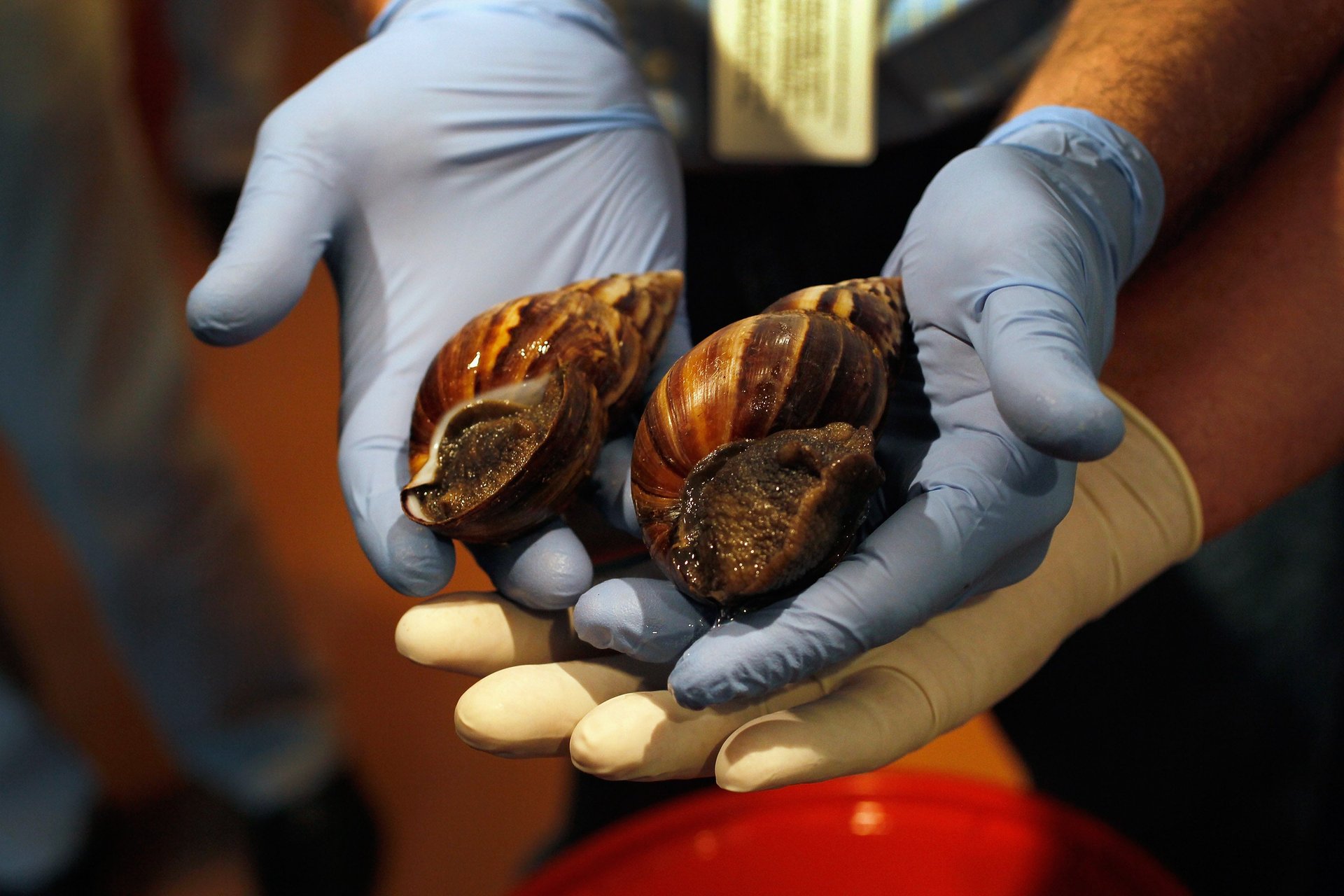Florida is now in the midst of three different quarantines... over snails
The sunshine state wants to save its crops from invasive mollusks

Florida is on high alert for snails. The state government designated part of southeastern Broward county a “quarantine and treatment area” after a giant African land snail, a highly invasive species of mollusk, was spotted north of Miami earlier this month.
Suggested Reading
But Broward isn’t alone. This is the third active quarantine against the land snail in Florida, according to the state’s department of agriculture and consumer services. Lee and Pasco counties, located on the state’s west coast, have protected against the snail since last year. The most recent quarantine covers a few square miles in Broward Country, including the Miami suburb of Miramar.
Related Content
A quarantine makes it illegal to move the snail, as well as any materials in which the mollusk—or its eggs—might be lurking. This effectively means that no soil, plants, or building materials can be moved out of the quarantine’s limits without permission from state authorities.
The scourge of the giant African land snail
The giant African land snail, easily recognizable by its brownish hue and large, rotund shell—isn’t a slow mover in all senses. It is able to reproduce without a mate (the hermaphroditic mollusk has both male and female reproductive organs) and can lay up to 1,200 eggs in a single year, meaning the snail’s population can quickly get out of hand.
The snail can grow relatively large, with an adult roughly the size of a human fist. Its spread can be disastrous for agriculture thanks to its ability to consume crops, as well as a hazard to homes with its tendency to consume weaker plaster and stucco structures.
It also often carries a parasitic nematode that can transmit meningitis-causing bacteria to humans.
“The giant African land snail is one of the most damaging snails in the world, consuming at least 500 different types of plants,” the state agriculture department wrote in a press release announcing the quarantine. “These snails could be devastating to Florida agriculture and natural areas as they cause extensive damage to tropical and subtropical environments.”
The snail also has a decades-long rapport in Florida. According to the US department of agriculture, the snail was first found in Florida in 1966, and cost $1 million (close to $6 million in today’s dollars) to eradicate it by 1975.
The snail reemerged in Florida in 2011, prompting numerous attempts to fight its spread in the past decade. The state and the federal government jointly declared the species eradicated in 2011 after they killed 168,000 snails and destroyed “innumerable eggs,” an effort that cost more than $23 million.
What other invasive species are attacking American ecosystems?
🐍 Burmese python: A snake native to southeast Asia, the Burmese python can grow to 23 ft. long. Scientists theorize the snakes were initially brought to the US as a pet, then escaped into the Florida Everglades during Hurricane Andrew in 1992. State officials correlate the snake’s increasing numbers with a precipitous drop in the region’s mammals, including a decline in the population of raccoons by 99.3%, opossums by 98.9%, and bobcats by 87.5% since 1997.
🐟 Snakehead: The northern snakehead a freshwater fish native to eastern Asia that has been found in American rivers in California and Maryland. The US National Park Service describes them as “voracious predators,” and reports that their ability to breathe oxygen while out of water has allowed them to spread geographically and threaten other freshwater species.
🪲 Asian lady beetle: The Asian lady beetle is an invasive species originally brought to the US by agricultural authorities to help control crop pests like aphids. The beetles are similar to a typical ladybug but bigger and hungrier, with some being known to eat ladybug eggs.
🪴 Kudzu: Perhaps the most prolific invasive species in North America, kudzu is a powerful weed that rapidly grows, cutting off nutrients to any plant that gets in its way. First introduced to the US as a few seeds in the late 19th century, kudzu has taken over 3 million hectares of land in the US and is estimated to be “consuming” land at a rate of 50,000 hectares per year climate crisis, causing soil to release its carbon into the atmosphere as a greenhouse gas.
Related stories:
What Guam can teach us about rescuing a destabilized ecosystem